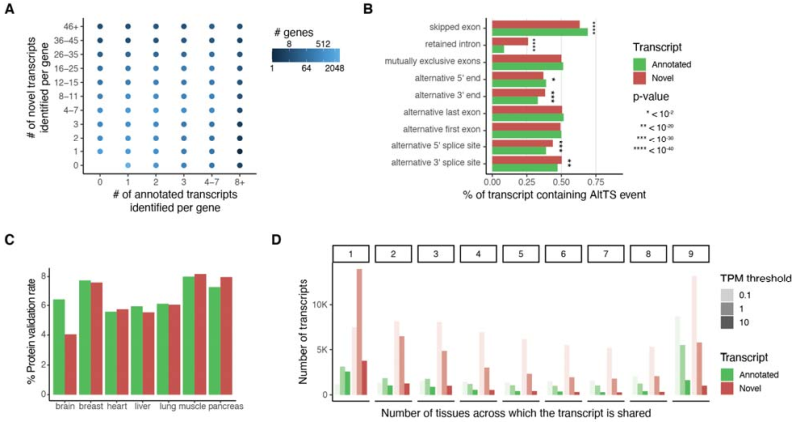Transcriptome variation in human tissues revealed by long-read sequencing
Release time:2022-04-28 15:19 Author:Benagen
Abstract
Regulation of transcript structure generates transcript diversity and plays an important role in human disease. The advent of long-read sequencing technologies offers the opportunity to study the role of genetic variation in transcript structure. In this paper, we present a large human long-read RNA-seq dataset using the Oxford Nanopore Technologies platform from 88 samples from GTEx tissues and cell lines, complementing the GTEx resource. We identified just under 100,000 new transcripts for annotated genes, and validated the protein expression of a similar proportion of novel and annotated transcripts. We developed a new computational package, LORALS, to analyze genetic effects of rare and common variants on the transcriptome via allele-specific analysis of long reads. We called allele-specific expression and transcript structure events, providing novel insights into the specific transcript alterations caused by common and rare genetic variants and highlighting the resolution gained from long-read data. We were able to perturb transcript structure upon knockdown of PTBP1, an RNA binding protein that mediates splicing, thereby finding genetic regulatory effects that are modified by the cellular environment. Finally, we use this dataset to enhance variant interpretation and study rare variants leading to aberrant splicing patterns.
 Fig 1 Discovery of new transcripts and comparison between tissues
Fig 1 Discovery of new transcripts and comparison between tissues
References
Dafni A Glinos, et al. Transcriptome variation in human tissues revealed by long-read sequencing. BioRxiv,2021
Regulation of transcript structure generates transcript diversity and plays an important role in human disease. The advent of long-read sequencing technologies offers the opportunity to study the role of genetic variation in transcript structure. In this paper, we present a large human long-read RNA-seq dataset using the Oxford Nanopore Technologies platform from 88 samples from GTEx tissues and cell lines, complementing the GTEx resource. We identified just under 100,000 new transcripts for annotated genes, and validated the protein expression of a similar proportion of novel and annotated transcripts. We developed a new computational package, LORALS, to analyze genetic effects of rare and common variants on the transcriptome via allele-specific analysis of long reads. We called allele-specific expression and transcript structure events, providing novel insights into the specific transcript alterations caused by common and rare genetic variants and highlighting the resolution gained from long-read data. We were able to perturb transcript structure upon knockdown of PTBP1, an RNA binding protein that mediates splicing, thereby finding genetic regulatory effects that are modified by the cellular environment. Finally, we use this dataset to enhance variant interpretation and study rare variants leading to aberrant splicing patterns.

References
Dafni A Glinos, et al. Transcriptome variation in human tissues revealed by long-read sequencing. BioRxiv,2021
 027-62435310 |
027-62435310 |
 service@benagen.com |
service@benagen.com |



